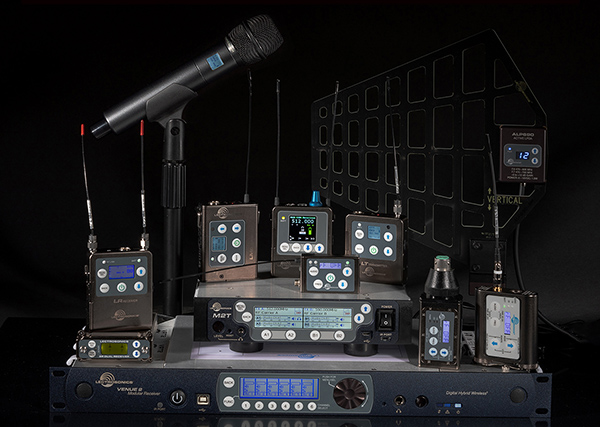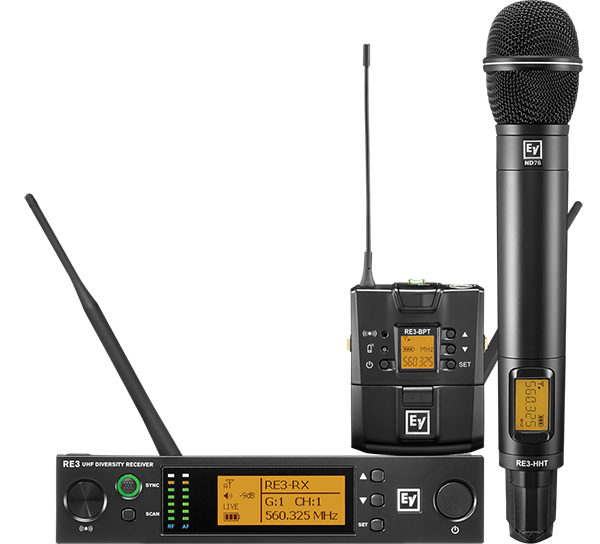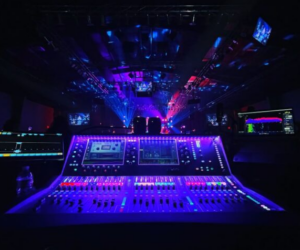The clock continues to run on wireless systems operating in the 600 MHz band. The U.S. radio frequency (RF) spectrum auction conducted by the Federal Communications Commission (FCC) resulted in the loss of 614 to 698 MHz (UHF channels 38-51), with the remaining usable bands being 470 to 608 MHz (UHF channels 14-36), joined by 174 to 216 MHz (VHF channels 7-13).
The corporations that spent billions to acquire this share of the radio spectrum are rapidly commencing services across the country. Once any auction winner begins testing in the 600 MHz spectrum in a region, it becomes illegal to operate wireless microphone (as well as in-ear monitoring and intercom) systems in that cellular block.
Putting it bluntly: wireless users should be putting alternative arrangements into place for all equipment operating above 608 MHz. It’s past time to be planning and budgeting for replacement or re-tuning (where applicable) existing systems. For more details and updates, be sure to visit ProSoundWeb on a regular basis as well as the websites of the FCC and a wide range of manufacturers.
Fortunately, all reputable wireless manufacturers have been planning for this eventuality by designing systems with wide tuning ranges, flexible operation, and good receiver filtering. Many transmitters also offer user-selectable RF power that can be quite helpful in tailoring for high-channel-count and short-distance applications.
In addition, a lot of work has gone into efficiently using the available spectrum, so that more wireless system channels can work together without interference within a particular 6 MHz television channel or other patch of available spectrum. Key to this spectral efficiency is digital transmission of the signal between the transmitter and receiver, as digital systems can be designed to offer important tradeoffs such as range, channel density and audio fidelity.
Further, more manufacturers now offer a range of options in the VHF bands, and there are also systems available in alternate bands, including 1.8 GHz, 2.4 GHz, 5 GHz, 6 GHz, and other bands as well. In general, these alternative bands are best used for specialized purposes because higher frequencies don’t have the same propagation characteristics as the VHF and lower UHF bands.
The introduction of digital wireless has also coincided with a push toward digital audio networking and computer control within the audio equipment chain. Touring-class wireless is likely to have the ability to be remotely monitored and controlled, and with integrated AES/EBU or (Audinate) Dante, receiver outputs can offer the option of keeping the signal in the digital domain from the stage through the console to the loudspeaker system.
Some systems have also added technologies for increasing reliability and resistance to dropouts, transmitting the same signal on more than one frequency (frequency diversity) and transmitting the same audio data in different time slots (time diversity), with algorithms at the receiver reassembling the digital information into coherent order.
Because the emitted signal from the transmitter is digital and the source audio has been converted to data, the audio can be encrypted before it is sent – and therefore protected from being monitored by anything other than its assigned receiver. Security is now readily available for applications that require it. Encryption at levels of 128-bit and 256-bit is common, and at least one recent system has upped the ante to 512-bit encryption.
Attention has also been directed toward placing antennas closer to the performing area where the transmitters are in use. Some of the available antenna systems are active, boosting the received signal level before it travels to the receiver via coax cable. Directional antennas accomplish double duty, with increased sensitivity aimed toward the desired signals and lower sensitivity at the rear to attenuate interfering RF signals within their null zones.
Several manufacturers also offer very good, and constantly updated, software packages that help to manage and monitor wireless system performance over a network, from pre-show planning through post-performance analysis. With all of this in mind, the systems presented here in the following roundup are more powerful and flexible than ever before.
Lectrosonics Venue 2
lectrosonics.com
The Lectrosonics Venue 2 receiver is a modular solution that effectively deals with a congested RF spectrum with a variety of options that allows a system configuration to be idealized for a particular installation or application.
Flexibility is the core concept of the design. The receiver modules can be operated separately, each with switched diversity reception for a total of six audio channels or operated in pairs for more robust diversity reception with one audio channel per module pair. Combinations can also be used for special applications where some modules operate independently and others are paired.
The receiver modules are easy to change with no tools required. The wideband multicoupler allows the use of any frequency module in any position, except when modules are paired for ratio diversity reception. Further, the supplied Wireless Designer software supplied software simplifies setup and provides access to all Venue 2 features in an easily navigable GUI. Other capabilities include spectrum scanning and frequency coordination.
TECH FOCUS: Digital Hybrid Wireless technology combines digital audio with an analog FM radio link to provide both outstanding audio quality and exemplary, noise-free RF performance. A patented algorithm encodes 24-bit digital audio in the transmitter into an analog format, the encoded signal is then transmitted over an analog FM wireless link. At the receiver, the signal is then decoded to restore the original digital audio. This process eliminates compandor artifacts and produces an audio frequency response flat to 20 kHz.
OF NOTE: A major benefit of the design is the inclusion of a high-quality antenna multicoupler. The multicoupler is actually a dual 1-input, 7-output splitter with six outputs for the receiver modules and an additional output as a “loop thru” for another Venue receiver. This allows multiple receivers to operate from a single pair of antennas. In addition, phantom power for remote antenna amplifiers is available from the multicoupler antenna inputs via menu selection.
KEY SPECIFICATIONS
RF Transmission: Digital Hybrid
Frequency Band: UHF (multiple bands between 470 – 691 MHz)
Receiver Bandwidth: 75 MHz
Frequency Agility/RF Search: Agile; scan and spectrum analyzer mode
Diversity Scheme: Antenna phase switching or ratio true diversity
Receiver Format: 1RU master unit with up to 6 channel modules
Receiver Outputs: Analog
Audio Bandwidth: 40 Hz – 20 kHz (+/-1 dB)
Sampling Rate: 24-bit/88 kHz
Latency: < 3.0 ms
Transmitter RF Power: Variable; 20/50/100/250 mW, depending on transmitter
Tx/Rx Communication: Via infrared
Control/Interfacing: RS-232, USB, and RJ-45 Ethernet ports; monitor and control with Wireless Designer software
Notes: Modular design with up to six receiver modules per chassis; internal wideband antenna multicoupler with loop-through; DSP emulation modes for compatibility with analog wireless systems in addition to Digital Hybrid mode.
Electro-Voice RE3
electrovoice.com
RF Transmission: Analog
Frequency Band: UHF (488 – 524 MHz, 560 – 596 MHz, other bands available including 653 – 663 duplex gap)
Receiver Bandwidth: 36 MHz (1,400 selectable frequencies) for 488 – 524 MHz and 560-590 MHz
Frequency Agility/RF Search: Frequency scan & sync
Diversity Scheme: True diversity
Receiver Format: Half-rack/1-channel
Receiver Outputs: Analog
Audio Bandwidth: 51 Hz – 16 kHz (handheld); 63 Hz – 16 kHz (bodypack, both +/-2 dB)
Transmitter RF Power: Variable, 10/50 mW
Notes: 10 sets available – five handheld transmitters and five bodypacks; LCD display for viewing all menus and operating parameters; receiver includes all necessary rack-mount hardware.
Shure Axient Digital
shure.com
RF Transmission: Digital
Frequency Bands: 470 – 960 MHz (varies by region)
Receiver Bandwidth: Up to 184 MHz
Frequency Agility/RF Search: Agile; scanning
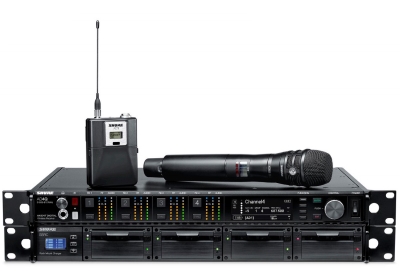
Receiver Format: Dual- and quad-channel (both 1RU)
Receiver Outputs: Analog, Dante or AES3 digital audio
Audio Bandwidth: 20 Hz – 20 kHz
Sampling Rate: 24-bit/48 kHz
Latency: 2.0 ms (standard mode)
Transmitter RF Power: Variable, 2/10/35 mW
Tx/Rx Communication: IR sync
Control/Interfacing: Networked control with Wireless Workbench and ShurePlus Channels iOS app; ShowLink remote control
Notes: Front panel headphone jack enables Dante Cue and Browse monitoring; configurable Ethernet switch for redundant Dante or AES67 digital output; DC module version available to support redundant power.
Audio-Technica 3000 Series (Fourth Generation)
audio-technica.com
RF Transmission: Analog
Frequency Band: 470 – 530 MHz and 530 – 590 MHz
Receiver Bandwidth: 25 MHz (minimum)
Frequency Agility/RF Search: Auto scan and sync
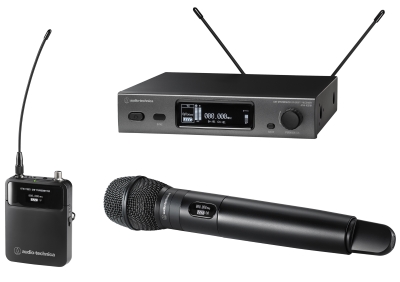
Receiver Format: 1/2RU 1-channel
Receiver Outputs: Analog (balanced XLR; unbalanced 1/4-inch)
Audio Bandwidth: 25 Hz–16.7 kHz (with handheld transmitter)
Transmitter RF Power: 10/30 mW
Tx/Rx Communication: Pilot tone
Notes: Multifunction button on transmitters can be used to switch to backup frequency; dual-mode receiver display can switch between standard view or performance view that highlights key metering; handheld transmitter works with six interchangeable A-T mic capsules and other compatible capsules.
Audix Performance Series
audixusa.com
RF Transmission: Analog
Frequency Band: UHF, 522 MHz – 586 MHz (R61/62 receivers)
Receiver Bandwidth: 64 MHz (R61/62)
Frequency Agility/RF Search: Auto scan and sync of 207 pre-coordinated
frequencies

Receiver Format: 1/2RU 1-channel, 1RU 2-channel
Receiver Outputs: Analog (XLR & 1/4-inch)
Audio Bandwidth: 45 Hz – 18 kHz
Sampling Rate: N/A
Transmitter RF Power: Variable, 10 and 40 mW
Tx/Rx Communication: Pilot tone
Control/Interfacing: N/A
Of Note: Modular interchangeable capsules for OM Series and VX5 vocal mics with HH; 16 systems (conservatively) can be used simultaneously; 2,560 individual frequencies available for manual tuning.
Sennheiser Digital 6000
sennheiserusa.com
RF Transmission: Digital
Frequency Band: UHF, 470 – 714 MHz
Receiver Bandwidth: 244 MHz
Frequency Agility/RF Search: Agile; scanning and spectrum
analyzer function

Receiver Format: 1RU/2-channel
Receiver Outputs: Analog, AES digital, Dante version also available
Audio Bandwidth: 30 Hz – 20 kHz (+/-1.5 dB)
Sampling Rate: 24-bit/variable 44, 48, 88, 96 kHz
Latency: 3 ms
Transmitter (SKM 6000 HH) RF Power: 25 mW (RMS), 50 mW (peak)
Tx/Rx Communication: IR sync
Control/Interfacing: Ethernet with WSM software
Notes: AES 256-bit encryption; free firmware update for EM 6000 receivers enables Command function that lets users set up a talkback channel with suitable transmitters; EM 6000 Dante has also been upgraded to include a secondary Dante port.
MIPRO ACT 8 Series
avlex.com, mipro.com.tw
RF Transmission: Digital
Frequency Band: 480 – 544, 540 ¬– 604 MHz
Receiver Bandwidth: 64 MHz
Frequency Agility/RF Search: Each channel has 4 preset “hopping” frequencies; AutoScan scanning
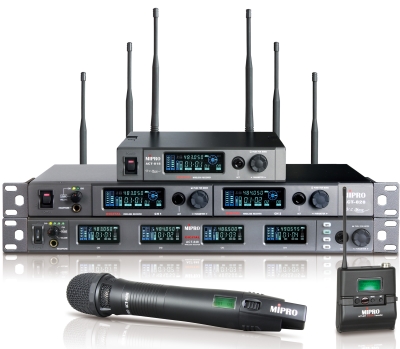
Receiver Format: Single- (1/2 RU), dual- and quad-channel (both 1 RU)
Receiver Outputs: Analog and Dante digital
Audio Bandwidth: 20 Hz – 20 kHz
Sampling Rate: 24-bit/44.1 kHz
Latency: < 2.7 ms
Transmitter RF Power: Variable, 10/50 mW
Tx/Rx Communication: ACT Sync
Notes: 256-bit encryption; proprietary SmartEQ with capsule emulation; 219 presets and 17 groups per band; RCS27 software for real-time setup, control and monitoring; digital plug-on transmitter offered in addition to handheld and bodypack.
JTS UF-20
jts.com.tw
RF Transmission: Analog
Frequency Band: UHF, various bands from 470 – 960 MHz (530 – 605 MHz in U.S.)
Receiver Bandwidth: 75 MHz
Frequency Agility/RF Search: Agile with scanning capabilities

Receiver Format: Half-rack/1-channel
Receiver Outputs: Analog
Audio Bandwidth: 50 Hz – 18 kHz
Sampling Rate: N/A
Latency: N/A
Transmitter RF Power: Variable, 10 mW/50 mW
Tx/Rx Communication: REMOSET ID Pairing
Control/Interfacing: N/A
Of Note: Antenna cascading across up to 10 receivers; interchangeable microphone capsules; communication of transmitter status includes RF power, sensitivity setting, low cut filter setting, and user name.
AKG DMS800
akg.com
RF Transmission: Digital
Frequency Band: UHF (Various bands ranging between 548 – 832 MHz)
Receiver Bandwidth: 150 MHz
Frequency Agility/RF Search: Agile; scan and spectrum analyzer functions
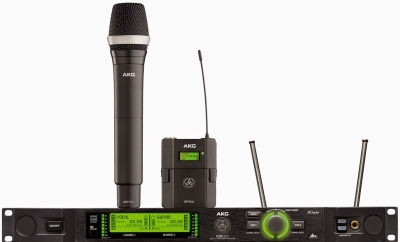
Receiver Format: 1RU/2-channel
Receiver Outputs: Analog; Dante and AES/EBU digital
Audio Bandwidth: 25 Hz – 20 kHz (+/-3 dB)
Sampling Rate: 24-bit/44 kHz
Latency: < 4 ms
Transmitter RF Power: Variable, 10/20/30/50 mW
Tx/Rx Communication: IR sync
Of Note: 512-bit encryption; Dante and AES/EBU digital outputs; optional network remote control for frequency coordination and multi-channel system monitoring; available in sets customized for vocalists and performers.
CAD Audio CADLive 3000 Series
cadaudio.com
RF Transmission: Analog
Frequency Band: UHF (580 – 600 MHz, 655 – 679 MHz)
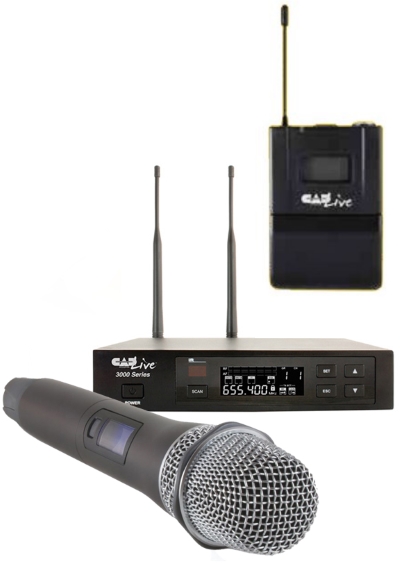
Frequency Agility/RF Search: Agile; proprietary ScanLink to
select optimum channel
Diversity Scheme: True diversity
Receiver Format: Half-rack/1-channel
Receiver Outputs: Analog
Audio Bandwidth: 40 Hz – 15 kHz
Sampling Rate: N/A
Latency: N/A
Transmitter RF Power: Variable 10/30/50 mW
Tx/Rx Communication: N/A
Control Interfacing: N/A
Of Note: Proprietary CADLock helps eliminate unauthorized transmissions in signal path; HH outfitted with D90 supercardioid dynamic capsule; bodypack transmitters include Equitek E19 earworn and E29 lavalier mics.
beyerdynamic TG 1000
north-america.beyerdynamic.com
RF Transmission: Digital
Frequency Band: UHF (470 – 789 MHz; available at 470 – 698 MHz)
Receiver Bandwidth: 319 MHz
Frequency Agility/RF Search: Agile; scanning
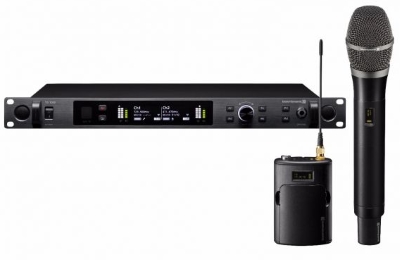
Receiver Format: 1RU/2-channel
Receiver Outputs: Analog
Audio Bandwidth: 20 Hz – 20 kHz
Sampling Rate: 24-bit/44 kHz
Latency: < 2.1 ms
Transmitter RF Power: Variable, 10/50 mW
Tx/Rx Communication: IR sync
Control/Interfacing: IP-based control using Chameleon software;
control via computer, tablet, smart phone
Of Note: Switchable encryption; antenna cascading through 12 receivers; company also offers the Opus 910 Series with receiver chassis housing one, two, and four channels depending on model.
LD Systems U508 HHC 2
ld-systems.com
RF Transmission: Analog
Frequency Band: UHF, 584 – 608 MHz (other bands also offered in 500 Series)
Receiver Bandwidth: N/A
Frequency Agility/RF Search: Auto scan function

Receiver Format: 1RU/2-channel
Receiver Outputs: Analog (XLR, TRS and switchable line/instrument)
Audio Bandwidth: 60 Hz – 16 kHz
Transmitter RF Power: 2/10/30 mW
Tx/Rx Communication: IR sync
Control/Interfacing: High-contrast OLED displays on receiver and transmitter
Of Note: Choice of several dynamic and condenser mic capsules with handheld transmitters; 500 Series also offers versions with bodypack transmitters and a conferencing system; pilot tone prevents noise from interfering signals; provided with rugged transport case.
Line 6 XD-V75
line6.com
RF Transmission: Digital
Frequency Band: 2.4 GHz
Receiver Bandwidth: 75 MHz
Frequency Agility/RF Search: Agile; Scanning

Receiver Format: Half-rack/1-channel
Receiver Outputs: Analog
Audio Bandwidth: 10 Hz – 20 kHz (-2.5 dB)
Sampling Rate: 24-bit/44 kHz
Latency: < 2.9 ms
Transmitter RF Power: Variable, 3.3/10 mW
Tx/Rx Communication: IR sync
Control/Interfacing: N/A
Of Note: EQ and mic capsule modeling; encrypted transmission; select from up to 14 channels; compatible with many other components making it feasible to combine handhelds, lavaliers, headsets and instruments within same system.
Sony DWX Series
pro.sony.com
RF Transmission: Digital
Frequency Band: UHF (three bands between 470 – 698 MHz)
Receiver Bandwidth: 72 MHz
Frequency Agility/RF Search: Agile; scan and spectrum analyzer
function
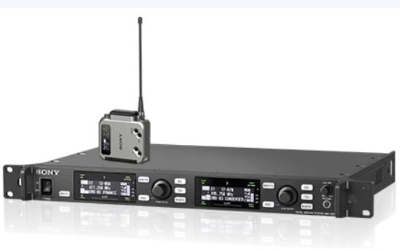
Receiver Format: 1RU/2-channel
Receiver Outputs: Analog; AES3 digital
Audio Bandwidth: 20 Hz – 22 kHz
Sampling Rate: 24-bit/48 kHz
Latency: < 3.4 ms
Transmitter RF Power: Variable, 1/10/50 mW
Tx/Rx Communication: 2.4 GHz bi-directional link
Control/Interfacing: Ethernet with Wireless Studio 3.0 software
Of Note: Proprietary encryption; transmitter “sleep” mode; thread-on capsules on HH; ENG-format receiver available.



